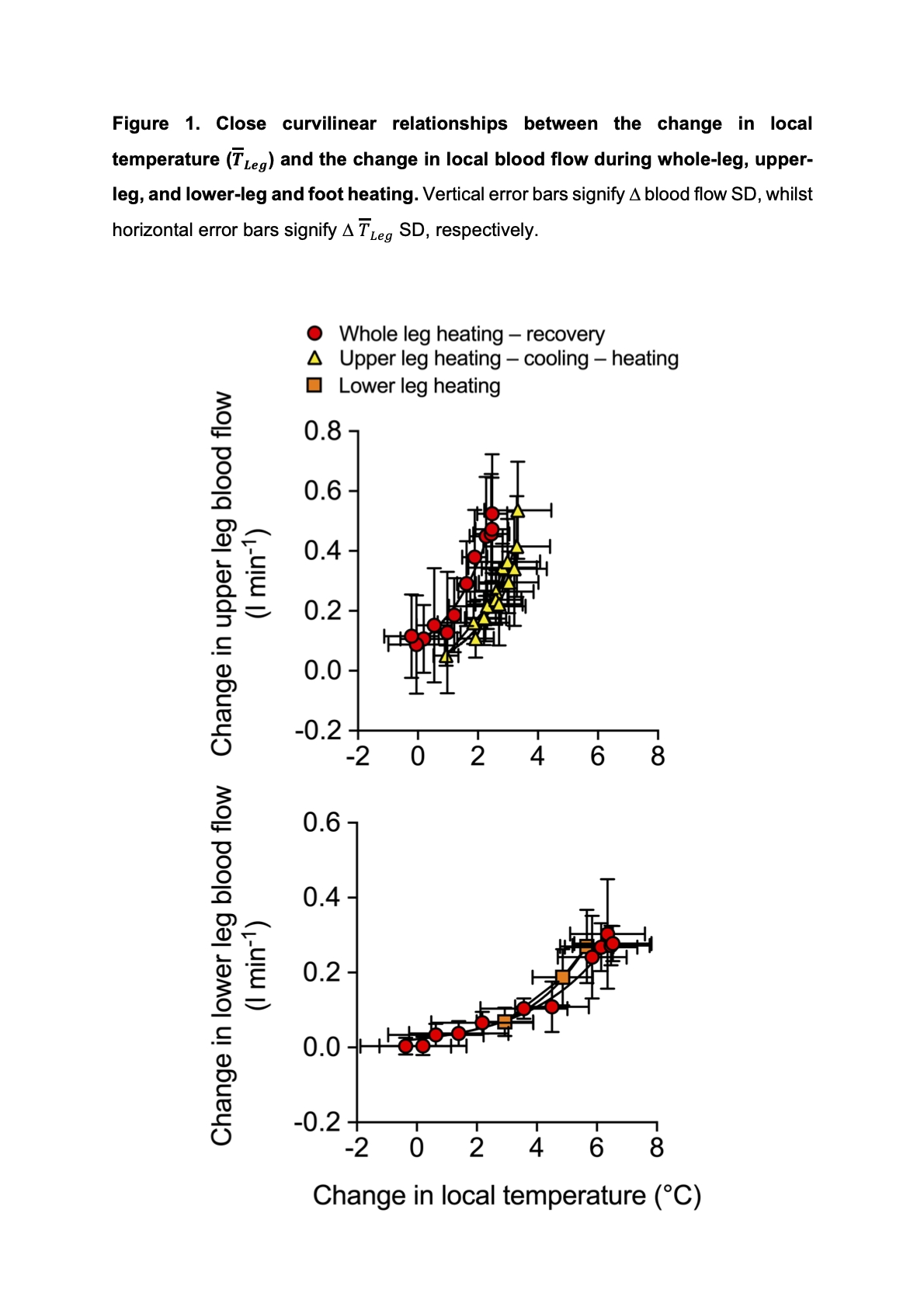Hyperthermia is thought to increase limb tissue blood flow through the activation of thermosensitive mechanisms within the limb vasculature (1). However, the precise vascular locus in which hyperthermia modulates perfusion, specifically in the different segments of the human leg, remains elusive. We tested the hypothesis that temperature-sensitive mechanisms alter limb haemodynamics by regulating microvascular blood flow. Methods: A cohort of healthy males and females (30±12 years; mean ± SD) participated in three protocols: (a) 3 h of whole-leg heating followed by 3 h of recovery (n=9); (b) 1 h of upper-leg heating followed by 30 min of cooling and 1 h bout of upper-leg heating (n=8) and (c) 1 h of lower-leg heating (n=8). Leg haemodynamics of the common (CFA), superficial (SFA) and profunda (PFA) femoral arteries and popliteal artery (POA) of the experimental and control leg were measured at regular intervals (every 10–30 min depending on the protocol) throughout protocols using a duplex Doppler ultrasound system. Furthermore, temperature and oxygenation profiles of the experimental and control leg were measured continuously throughout the protocols. Two-way repeated measures ANOVA tests were performed to investigate differences in haemodynamics, flow profiles and temperature between and within the experimental and control leg/leg segment over time. Additionally, regression analysis was performed to assess the relationship between various key data. Results: Whole-leg heating increased experimental average leg temperature (TLeg) by 4.2±1.2ºC and blood flow in the CFA, SFA, PFA and POA by ≥3-fold, whilst core and control-leg temperatures and haemodynamics remained stable. Upper- and lower-leg blood flow increased by 525±199 and 278±49 ml·min-1 (p<0.0001), respectively, in direct response to the rise in local TLeg (R2=0.95; p<0.0001) and then declined during recovery. Furthermore, upper-leg heating increased upper TLeg by 3.3±1.1 ºC (p<0.0001) and upper-leg blood flow by 536±162 ml·min-1 (p<0.0001), without any changes to lower TLeg tissue oxygenation or blood flow. These are comparable to whole-leg heating responses. Conversely, lower-leg heating increased lower TLeg and blood flow—5.7±0.9ºC and 270±98 ml·min-1 (p0.1). Throughout all three protocols, changes in blood flow were directly related to changes in local TLeg (R2=0.97; p<0.0001) (Fig. 1). Conclusion: Findings demonstrate that whole-leg hyperthermia induces profound and sustained elevations in upper- and lower-limb blood flow and that segmental hyperthermia matches the regional thermal hyperaemia, without causing thermal or haemodynamic alterations in the non-heated limb segment. These observations support the notion that heat-activated haemovascular mechanisms in the microcirculation regulate limb tissue perfusion during hyperthermia. Importantly, the markedly enhanced hyperaemia and tissue oxygenation lend support to the therapeutic potential of local hyperthermia for treatment of circulatory diseases.
Future Physiology 2021 (Virutal) (2021) Proc Physiol Soc 47, PC07
Poster Communications: Regional thermal hyperaemia in the human leg: insight into the role of thermosensitive mechanisms in the control of the peripheral circulation
Nuno Koch Esteves1, Oliver Gibson1, 2, Ashraf Khir1, 3, José Gonzalez-Alonso1, 2
1 Centre for Human Performance, Exercise and Rehabilitation, College of Health, Medicine and Life Sciences, Brunel University London, Uxbridge, United Kingdom 2 Division of Sport, Health and Exercise Sciences, Department of Life Sciences, College of Health, Medicine and Life Sciences, Brunel University London, Uxbridge, United Kingdom 3 Department of Mechanical and Aerospace Engineering, College of Engineering, Design and Physical Sciences, Brunel University London, Uxbridge, United Kingdom
View other abstracts by:
Where applicable, experiments conform with Society ethical requirements.

